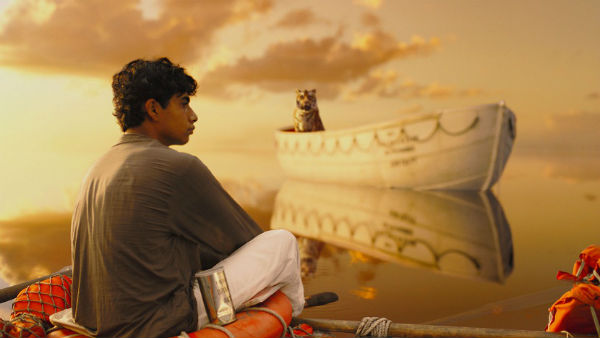Review – Life of Pi
|
All movies are, on some level, seeking to manipulate you like a marionette, pulling your various emotional strings in order to evoke their intended reaction. The best movies do this without you realizing you are being manipulated. The worst are clunky and lack all subtlety or they are a jumbled mess that tangle your various strings and leave you feeling nothing.
Life of Pi makes absolutely no attempt to disguise its string pulling. The film is an extended allegory on the power of religion. I know that this is what the film is about because the film told me this is what it’s about. The main character Pi Patel (Irrfan Khan) tells a writer (Rafe Spall) the story of his life, which the writer has been promised will prove the existence of God.
The heavy handedness of the scenes between Patel and the writer are a bit grating. The film spells out everything for the audience and the discussions between the two characters don’t feel organic. Khan, for his part, plays Pi earnestly and serves as an effective narrator, but Spall’s performance seems forced. None of his dialogue feels natural.
Depending on your personal beliefs, your mileage will likely vary on how effective the film is at making it’s case for religion. Without opening up a giant theological can of worms, I think it’s safe to say that the film is unlikely to convert any atheists, though those who have faith in a god are likely to leave the theater with their faith reaffirmed.
What’s so surprising about the film is that even though it isn’t terribly subtle in it’s intent, it is actually an incredibly entertaining and beautifully shot film. Even if you aren’t interested in the larger theological implications of the film, director Ang Lee has created a gorgeous world for his characters to inhabit and he tells a very moving story of survival.
The main story that Pi tells the writer is of his time trapped in a life raft. A much younger Pi (Suraj Sharma) is aboard a freighter sailing from India that begins sinking during a storm. In a harrowing scene, Pi escapes on a lifeboat while the ship plunges into the water.
Pi’s family owned a zoo in India. They are selling all of the animals to start a new life in North America. so all of their animals are on the ship with them. As the ship crashes, the animals are sent out to sea as well.
This is how Pi ends up on a lifeboat with an orangutang, a wounded zebra, a hyena and a Bengal tiger. (The tiger, amusingly, due to a clerical error is named Richard Parker.) The bulk of the film takes place on Pi’s life raft as he attempts to survive both the perils at sea and the perils of sharing a boat with a variety of animals, including a massive hungry, scared carnivore.
Religious allegory aside, it is during Pi’s 227 days at sea that the film truly shines. Visually, the film is absolutely gorgeous during this time period and emotionally Lee gets you invested in Pi’s struggle to survive and to find the strength to keep going.
The CGI in the film is amazing. Richard Parker and all of the other animals look almost flawless. The way they move and interact with Pi and each other is completely believable. I never found myself questioning the effects used to make them come to life. Instead, I just accepted Richard Parker as a tiger sharing a lifeboat with Pi, which is key in making the film work.
In addition to the animals, Lee serves up some other wonderful visuals. In one scene, a score of jellyfish swim underneath the boat, giving the water this beautiful neon blue glow. In another scene, the water becomes a perfect mirror for the sky, making it look like the boat is floating through space. Having the bulk of the film take place in the same location – a small lifeboat at sea – could get boring visually very quickly, but in Lee’s hands, it’s an incredibly versatile and gorgeous setting.
The 3D is quite good, as well. In general, I’m not a huge 3D fan, but I did appreciate the fact that this movie was conceived as a 3D film, instead of being converted after being shot to make some extra cash. At times, the 3D is used rather effectively, particularly in the shipwreck scene as Pi is plunged into the water and struggles to not drown. Still, I’m not sure how vital to the experience the 3D is. You could easily save the extra cash and simply enjoy the lavish set pieces in regular old 2D.
Life of Pi is unlikely to change your life. Despite the film’s boasts, Pi’s story probably won’t convince any non-believers of the existence of God. But, regardless of your beliefs, Ang Lee serves up a visually stunning and well-told story of survival that shines on the big screen.
Written by Joel Murphy. If you enjoy his reviews, he also writes a weekly pop culture column called Murphy’s Law, which you can find here. You can contact Joel at murphyslaw@hobotrashcan.com.




